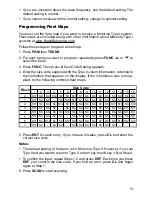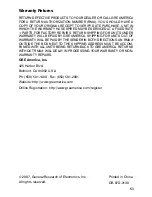
61
GLOSSARY
Frequency
– the receiving signal location (expressed in MHz). To find active
frequencies, you can use frequency guides, frequency listings posted on the
Internet, or the built-in search function.
Channels
– programmable memory locations for the frequencies you want to
monitor. Each time the scanner finds an active frequency, it stops and monitors
the radio traffic on that channel until the transmission ends, then resumes scan-
ning.
Channel Storage Banks
– a storage area for a group of channels. Channels
are storage areas for frequencies. Whereas a channel can only contain one
frequency, a bank can hold numerous channels.
Talkgroup IDs
– each channel storage bank has an associated tralkgroup ID
list, for a total of 10 talkgroup ID lists. Each ID list has 5 sub-banks. Each sub-
bank has 30 ID locations. You can program up to 150 talkgroup IDs in each
bank, so you can program up to 1500 talkgroup IDs in 10 banks. When the
scanner stops on a transmission in the Motorola or EDACS mode, it checks to
see if the ID has been stored in the associated ID list. In the Closed Mode, the
scanner only stops on the transmission and displays its text tag if you have
stored and not locked out the ID. In the Open Mode, the scanner always stops
on all transmissions except those you specifically exclude, and displays the
ID’s text tag if you have stored the ID. For a detailed description of Open and
Closed Mode operation, see “Open and Closed Mode Operation”.




































